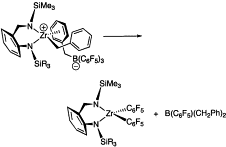Publication 4
- Double Bonds in Motion: Bis(oxazolinylmethyl)pyrroles and Their Metal-Induced Planarization to a New Class of Rigid Chiral C2-symmetric Complexes
Clément Mazet, Lutz H. Gade*
Chem. Eur. J. 2003, 9, 1759-1767

The synthesis of a new class of chiral C2-symmetric tridentate Ndonor ligands, a series of 2,5-bis(2-oxazolinylmethyl)pyrroles, was achieved in four steps starting from the known 2,5-bis(trimethylammoniomethyl)pyrrole diiodide (1). Reaction of 1 with NaCN in dimethyl sulfoxide gave 2,5-bis(cyanomethyl)pyrrole (2) cleanly, which was then cyclized with amino alcohols to give the 2,5-bis(2-oxazolinylmethyl)pyrroles 3 a–c (3 a: bis[2-(4,4′-dimethyl-5-hydrooxazolyl)methyl]pyrrole; 3 b: (S,S)-bis[2-(4-isopropyl-4,5-dihydrooxazolyl)methyl]pyrrole; 3 c: (S,S)-bis[2-(4-tertiobutyl-4,5-dihydrooxazolyl)methyl]pyrrole). Metallation of 3 a–c with one molar equivalent of tBuLi and their subsequent reaction with a stoichiometric amount of [PdCl2(cod)] (cod=cyclooctadiene) gave the palladium(ii) complexes 4 a–c. Whereas the arrangement of the Ndonor atoms in the crystallographically characterized complex 4 a is almost ideally square planar, all three heterocycles in the ligand are twisted out of the coordination plane, leading to a chiral conformation of the complex. Attempts to freeze out these two conformers in solution at 200 K (NMR) failed, and this suggests that the activation barrier for conformational racemization is significantly below 10 kcal mol−1. The palladium-induced shift of two double bonds as well as the porphyrinogen/porphyrin-type oxidation of the complexes 4 a–c led to the planarization of the 2,5-bis(oxazolinylmethyl)pyrrolide ligands in the palladium(ii) complexes 5 a–c, 6 b, and 6 c, and to the formation of rigid chiral C2-symmetric systems as shown by Xray diffraction studies. The formation of the conjugated system of double bonds in this transformation is accompanied by the emergence of an intra-ligand chromophore. This is evident in the absorption spectrum of 6 c which displays an intense band with a maximum at 485 nm attributable to an intra-ligand π*←π transition and a characteristic vibrational progression of ν≈1350 cm−1. Complexes 4 b and 4 c were tested in the catalytic asymmetric Michael addition of ethyl 2cyanopropionate to methyl vinylketone (catalyst loading: 1 mol %) and were found to give maximum ee values of 43 % (4 b) and 21 % (4 c) at low conversions.
archive ouverte unige:7771
DOI de la version éditeur : 10.1002/chem.200390202
